Employee benefits are a core part of workplace culture and a major factor in how people choose and stay with employers. Health coverage, retirement plans, wellness programs, and family support all shape how employees view their jobs. At the same time, HR teams manage complex plans while staying aligned with regulations.
Manual paperwork often slows the process and increases errors. Benefits administration software helps by automating enrollment, linking with payroll and carriers, and giving employees a clear, self-service way to manage their benefits.
This guide explains how these platforms work, highlights the features that matter, and provides leading options to help businesses choose the right system.
What Is Benefits Administration Software?
Benefits Administration Software is an HR technology that streamlines the entire benefits lifecycle plan setup, eligibility rules, open enrollment, life-event changes, evidence of insurability (EOI) workflows, carrier data exchange, compliance reporting, and ongoing communication while giving employees a clear, mobile-friendly way to enroll and manage their benefits.
Core outcomes it supports
- Fewer admin hours and fewer manual errors
- Stronger compliance (ACA, COBRA, Section 125, ERISA, local regs)
- Better employee experience and enrollment accuracy
- Cleaner, more consistent data across HRIS, payroll, and carriers
Why Companies Need Benefits Administration Software
Time Savings & Automation
Manual elections, spreadsheets, and paper forms create delays and errors. Automation handles eligibility, plan rules, and event-driven changes (marriage, birth, address updates), pushing accurate updates downstream to payroll and carriers.
Compliance & Error Reduction
With prebuilt compliance frameworks (ACA, COBRA, Section 125), the system can automate measurement/offer tracking, generate notices, and create audit-ready reports reducing penalties and rework.
Improved Employee Experience
Clear plan comparisons, cost calculators, and mobile access increase enrollment confidence, employees self-serve changes and documents, lowering HR tickets and improving satisfaction.
Better Data & Insights
Dashboards surface enrollment trends, participation gaps, and cost drivers. HR can model plan design changes, gauge adoption of wellness programs, and forecast spend.
Key Features of Benefits Administration Software
- Centralized Benefits Catalog: Configure medical, dental, vision, life, disability, commuter, HSAs/FSAs/HRAs, wellness stipends, and voluntary benefits in one place.
- Eligibility & Rules Engine: Set complex rules by location, union code, hours, status, waiting periods, and measurement periods.
- Open Enrollment (OE) & Life Events: Guided flows, plan comparisons, EOI capture, reminders, and approvals.
- Carrier Connectivity: EDI/API to send clean enrollment files and reduce carrier discrepancies.
- Payroll & HRIS Integrations: Two-way sync for deductions, employer contributions, and demographic data.
- Compliance & Reporting: ACA, COBRA data support, Section 125 documentation, ERISA notices, audit trails.
- Employee Self-Service: Mobile portal for elections, dependents, beneficiaries, documents, and ID cards.
- Analytics & Cost Modeling: Participation dashboards, per-capita cost views, scenario analysis.
- Security & Governance: SSO, role-based access, SOC 2/ISO controls, PHI safeguards.
Benefits of Using Benefits Administration Software
Reduced Administrative Burden
Automate eligibility, OE communications, and file feeds so HR can focus on strategic work (program design, vendor negotiations, and wellbeing initiatives).
Cost Efficiency
Cleaner data and fewer corrections reduce premium leakage, over-deductions, and reconciliation work. Automated communications cut print/postage costs.
Increased Employee Satisfaction
Modern, transparent UX builds trust. Calculators, plan summaries, and mobile access reduce confusion and last-minute support requests.
Scalability for Growing Businesses
Adding locations or headcount doesn’t require rebuilding processes; rules scale across groups, business units, and geographies.
Stronger Compliance & Risk Management
Out-of-the-box support for ACA tracking, COBRA events, and required notices helps you avoid fines and reputational risk.
How to Choose the Right Benefits Administration Software
- Company Profile: Headcount, locations, union/non-union, hourly vs. salaried, global footprint.
- Ecosystem Fit: Native HRIS features vs. best-of-breed; required integrations (payroll, time, ERP, IDP/SSO).
- Complexity of Plans: Eligibility rules, union differentials, multiple carriers, voluntary benefits.
- Admin Experience: Plan setup ease, file feed monitoring, data correction workflows, audit trails.
- Employee UX: Mobile OE flow, calculators, plan comparisons, multilingual content.
- Compliance Depth: ACA measurement, COBRA support (in-app or via TPA integration), Section 125 docs.
- Security & Privacy: Certifications, PHI handling, and least-privilege access.
- Service Model & Cost: Implementation approach, SLAs, renewal terms, pricing transparency.
List of Best Benefits Administration Software
1. ADP Workforce Now
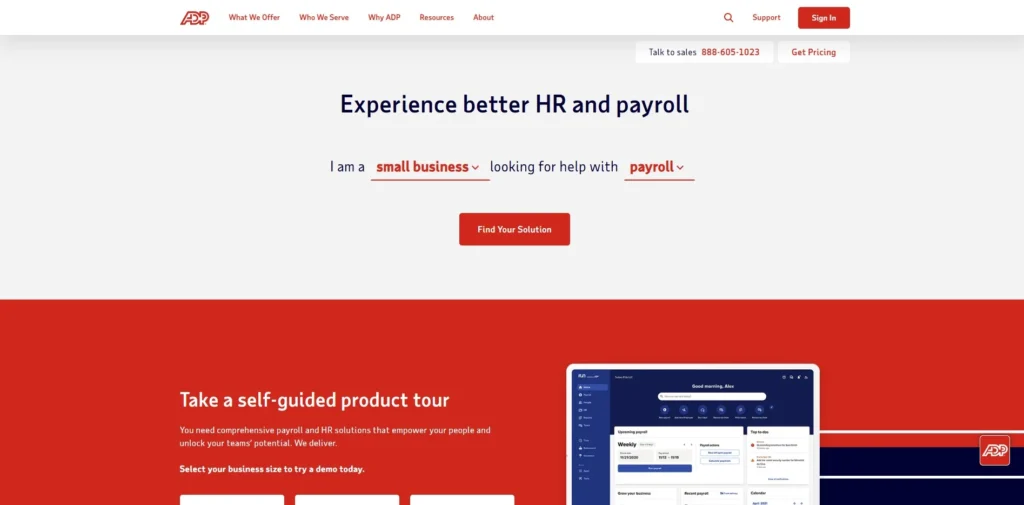
Website: https://www.adp.com
ADP Workforce Now is one of the most recognized global platforms for payroll, HR, and benefits administration. Built for medium to large enterprises, ADP helps organizations manage employee benefits across multiple regions with compliance-ready solutions. ADP continues to dominate the market with its extensive network of insurance carriers and integration with retirement, healthcare, and wellness plans.
Its cloud-based system centralizes HR, payroll, time tracking, and benefits, making it a one-stop solution for businesses seeking automation and accuracy. ADP’s reporting and analytics tools also enable HR teams to gain insights into benefit usage, costs, and employee engagement.
Key Features:
- Centralized benefits administration with healthcare, retirement, and wellness options
- Seamless payroll and compliance management
- Advanced reporting and workforce analytics
- Integration with major insurance carriers and retirement plans
Pricing:
- Custom pricing based on company size and requirements.
2. Gusto
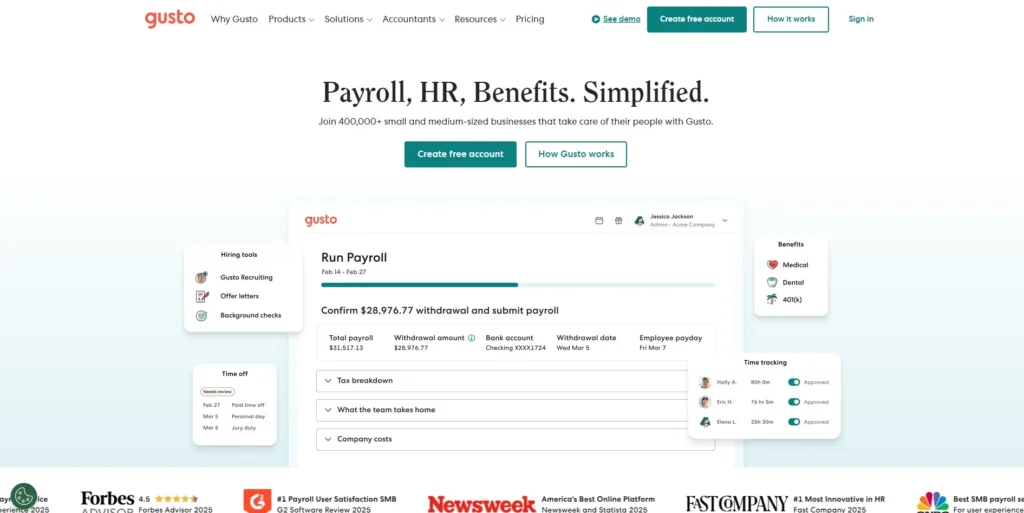
Website: https://www.gusto.com
Gusto is a popular HR and benefits software built with small to mid-sized businesses in mind. Known for its simplicity and modern design, Gusto makes it easy for employers to offer health insurance, dental, vision, retirement, and commuter benefits through a single platform. Gusto has expanded its coverage network across the U.S., making it more accessible for startups and growing teams.
The platform also handles employee onboarding, payroll, and tax filings, giving businesses an all-in-one HR experience. Gusto’s user-friendly dashboards and guided workflows are ideal for companies without a dedicated HR department.
Key Features:
- Health, dental, vision, retirement, and commuter benefits options
- Automated payroll with tax filing and compliance
- Employee self-service benefits enrollment
- Integration with accounting and productivity tools
Pricing:
- Simple – $49/mo + $6/mo per person
- Plus – $80/mo + $12/mo per person
- Premium – $180/mo + $22/mo per person
- Contractor Only – $0/mo (for first 6 months, then $35/mo) + $6/mo per person
3. bswift
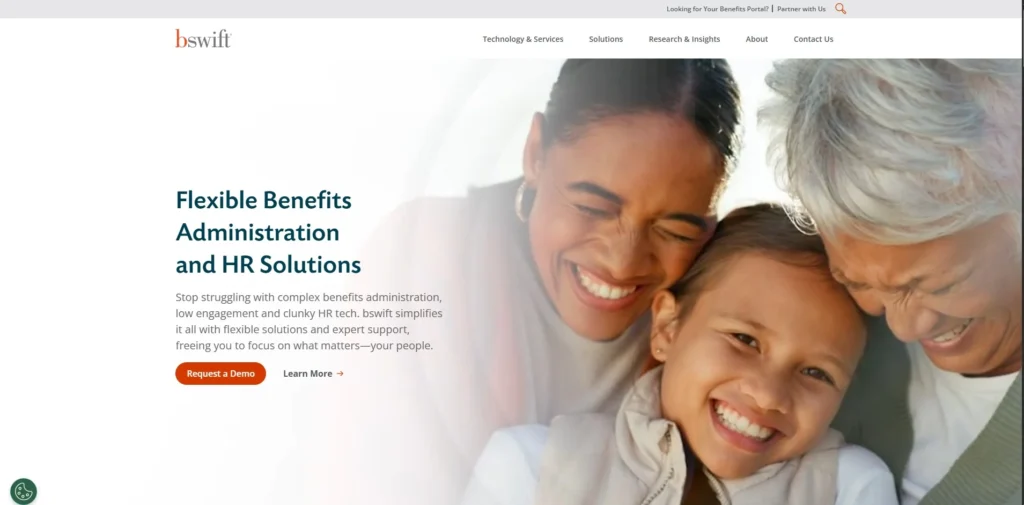
Website: https://www.bswift.com
bswift is a leading enterprise benefits administration platform trusted by large organizations and Fortune 500 companies. Backed by Aetna/CVS Health, bswift delivers a robust digital experience for employees to enroll, compare plans, and manage benefits. The platform provides decision-support tools, cost modeling, and wellness program integration.
HR teams benefit from strong compliance features, including ACA and COBRA automation, and carrier connectivity that reduces data errors. bswift’s scalability makes it ideal for organizations with complex ecosystem benefits ecosystems.
Key Features:
- Enterprise-grade open enrollment and eligibility management
- Decision-support tools and personalized cost calculators
- ACA and COBRA compliance automation
- Deep carrier integration and data accuracy tools
- Robust analytics and reporting capabilities
Pricing:
- Available on request
4. Paycor
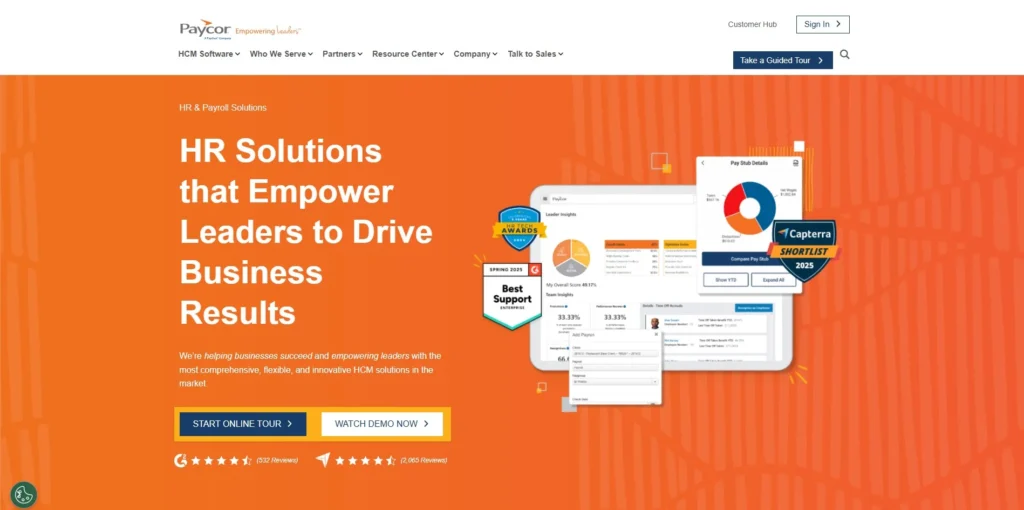
Website: https://www.paycor.com
Paycor provides HR and benefits administration tools tailored to small and mid-sized businesses. The platform specializes in making benefits selection and enrollment straightforward while maintaining compliance with ACA and other regulations. Paycor stands out with its AI-powered insights that help businesses optimize benefits, costs and improve employee satisfaction.
Its customizable dashboards allow HR teams to track employee participation rates and make data-driven decisions. Paycor also integrates with payroll and talent management systems, creating a seamless HR ecosystem.
Key Features:
- Benefits enrollment with compliance safeguards
- AI-driven analytics for cost optimization
- Mobile access for employees to manage benefits anytime
- Payroll, time, and talent management integrations
Pricing:
- Custom pricing based on employee count and features required
Suggested Read: Order Management Software
5. Rippling
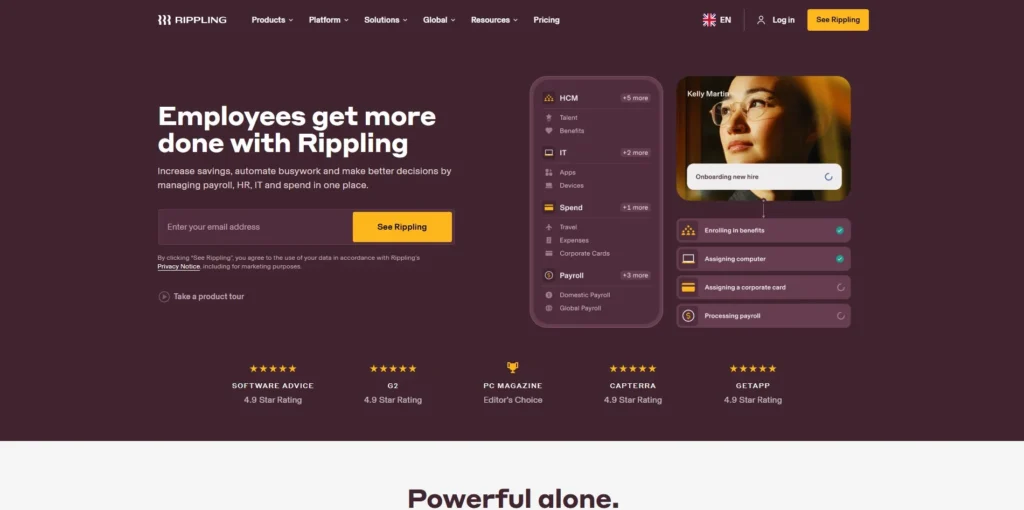
Website: https://www.rippling.com
Rippling is a fast-growing HR and IT platform that combines payroll, benefits, and device management in a single system. Known for its automation, Rippling simplifies benefits enrollment and syncing with insurance carriers. Rippling is a strong choice for businesses scaling globally, as it offers support for both U.S. and international teams.
With workflows that automatically update when an employee joins, leaves, or changes roles, Rippling reduces manual work for HR managers. Its marketplace of integrations also connects benefits administration with popular tools like Slack, QuickBooks, and Google Workspace.
Key Features:
- Automated benefits enrollment and carrier syncing
- Global payroll and compliance support
- IT and HR integration (e.g., device and app provisioning)
- Custom workflows and reporting tools
Pricing:
- Available on request
6. BambooHR
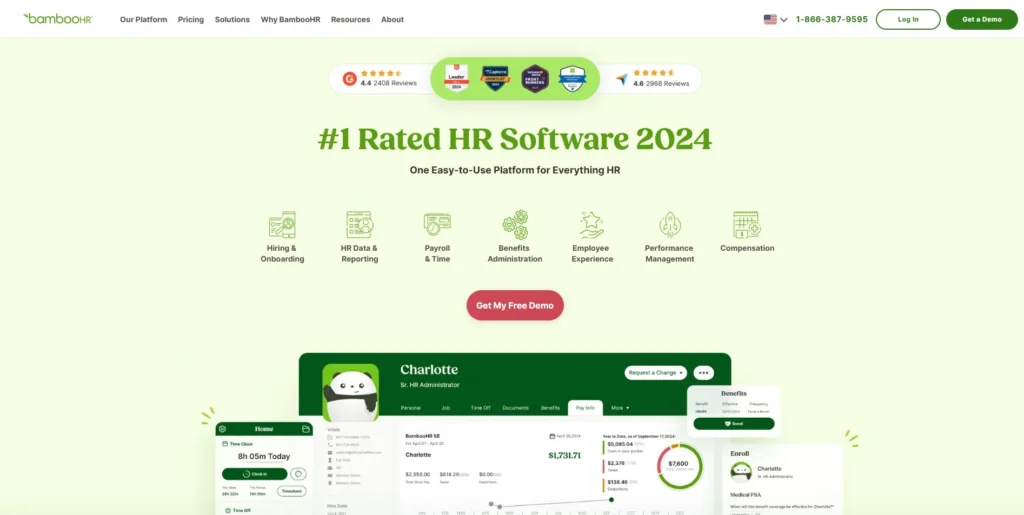
Website: https://www.bamboohr.com
BambooHR is an employee-focused HR platform that offers benefits administration, payroll, and performance management. While primarily known for its HR information system, BambooHR has grown into a full-service solution by adding robust benefits management features. It enables employers to centralize health, retirement, and wellness benefits into one dashboard.
The employee self-service portal allows staff to compare plan options, enroll digitally, and access their information anytime. Its clean design and usability make BambooHR especially attractive to small and mid-sized companies.
Key Features:
- Benefits tracking and enrollment
- Payroll and time-off management integration
- Employee self-service portal
- Customizable HR reporting
Pricing:
- Available on request.
7. TriNet
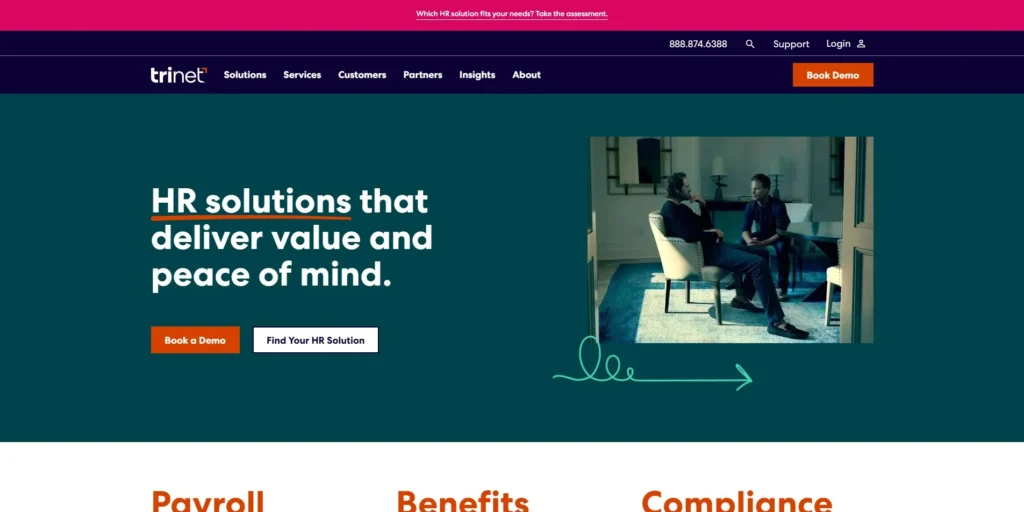
Website: https://www.trinet.com
TriNet is a leading global provider of full-service HR solutions that include benefits administration, payroll, compliance, and talent management. Designed for SMBs and mid-market companies, it helps organizations access enterprise-grade benefits without needing a large in-house HR team. TriNet partners with leading insurance carriers to offer medical, dental, vision, retirement, and other perks tailored to industry needs.
As businesses increasingly adopt flexible workforces and remote hiring, TriNet’s benefits administration ensures employees can enroll, manage, and track benefits easily through a modern digital platform. Its analytics tools also provide leaders with insights into costs and benefits usage, helping optimize investment.
Key Features:
- Access to top-tier benefits providers across health, retirement, and wellness.
- Intuitive self-service portal for employees and managers.
- Compliance support for ACA, HIPAA, and other global regulations.
- Integrated payroll and tax filing.
- Expert HR consulting and industry-specific guidance.
Pricing:
- Available on request
8. Benefitfocus
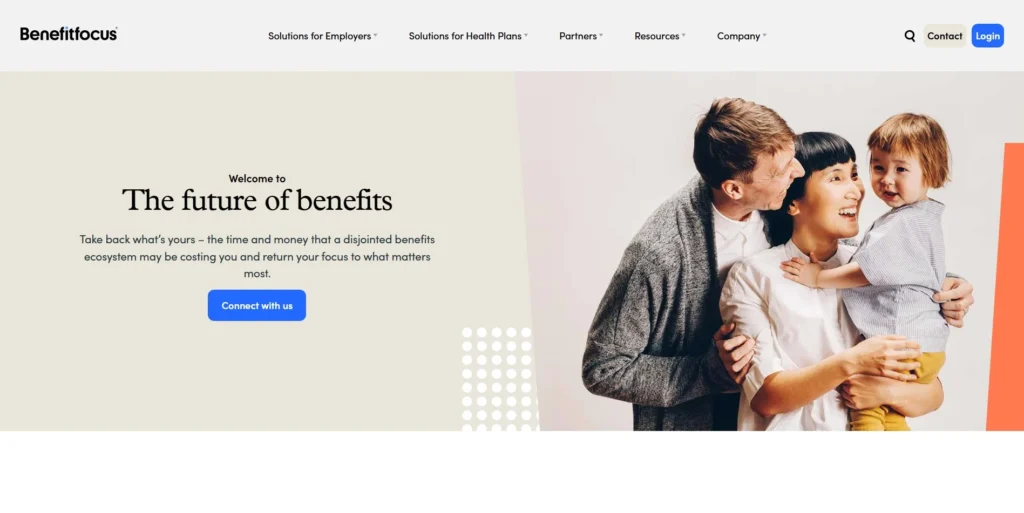
Website: https://www.benefitfocus.com
Benefitfocus is a benefits-first administration platform that connects employers, employees, and insurance carriers. It is widely used by enterprises and brokers to manage open enrollment, eligibility, compliance, and voluntary benefits. The platform offers an intuitive employee experience with decision-support tools, helping staff understand and select the right plans.
HR teams benefit from its carrier connectivity and real-time analytics that highlight participation trends and cost drivers. Benefitfocus also supports ACA and COBRA compliance out of the box, reducing regulatory risks for organizations.
Key Features:
- Digital open enrollment with decision-support tools
- Seamless carrier data exchange via EDI/API
- Compliance automation for ACA, COBRA, and Section 125
- Real-time dashboards and cost analytics
- Marketplace for voluntary and lifestyle benefits
Pricing:
- NOT Available
9. Workday HCM
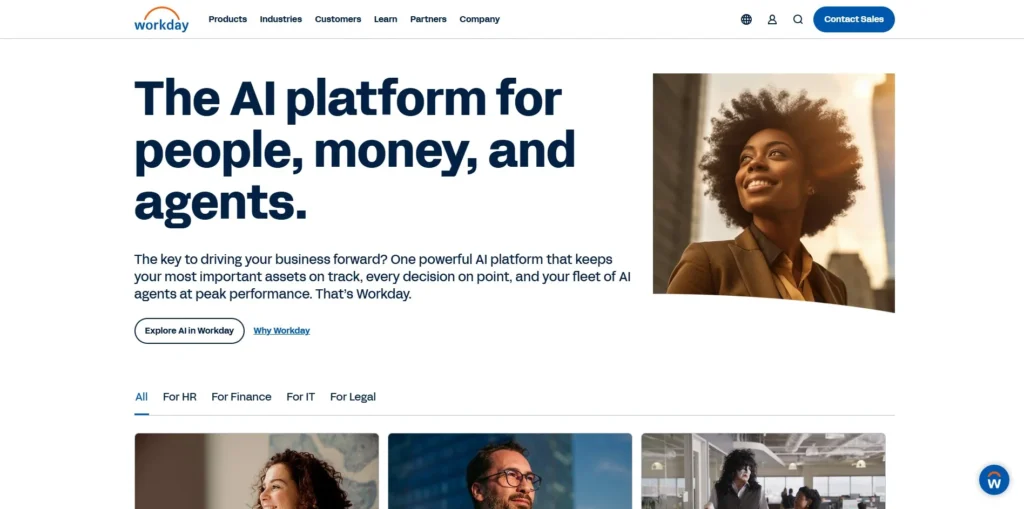
Website: https://www.workday.com
Workday HCM is a leading enterprise-grade HR platform that includes a powerful benefits administration module. It is designed for large and global organizations that need to manage complex eligibility rules, multiple carriers, and compliance across regions. Workday streamlines open enrollment, life-event updates, and evidence of insurability workflows, making it easier for employees to choose the right plans.
Its AI-driven analytics help HR leaders forecast benefits costs and model plan changes. Workday’s scalability and deep integrations with payroll and finance make it a go-to choice for multinational enterprises.
Key Features:
- Comprehensive open enrollment and life-event workflows
- Global compliance support with ACA, COBRA, and ERISA tracking
- AI-powered insights for cost forecasting and workforce planning
- Integration with payroll, finance, and ERP systems
- Employee-friendly portal with decision support tools
Pricing:
- Contact Sales
10. Namely
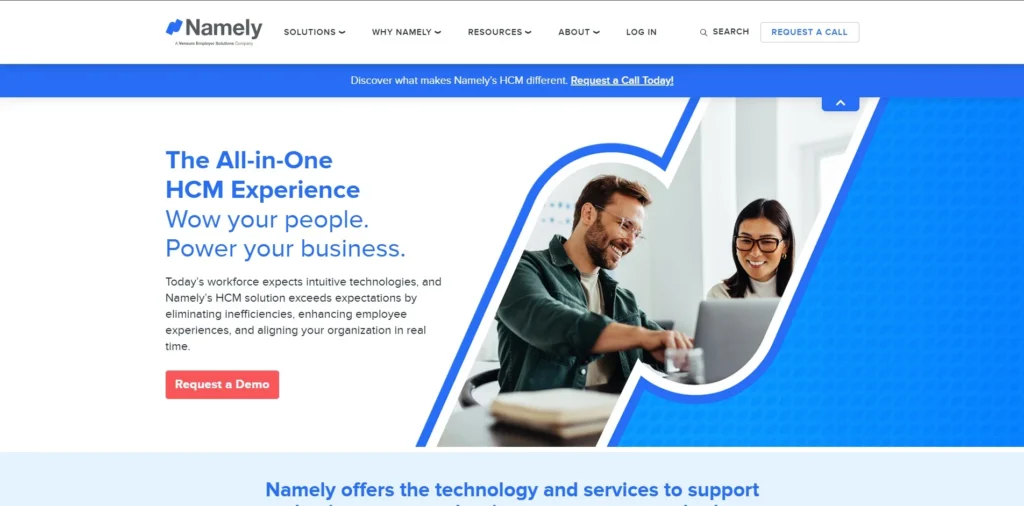
Website: https://www.namely.com
Namely is an all-in-one HR, payroll, and benefits administration software designed for mid-sized companies. Its benefits platform integrates medical, dental, vision, and retirement plans, enabling employees to manage their coverage with ease. Namely stands out for its modern user experience and ability to handle complex compliance needs for growing businesses.
HR administrators can easily run reports, track enrollment, and manage renewals, while employees enjoy self-service portals and mobile access. Namely also provides dedicated benefits advisors to help organizations choose the right plans, making it a blend of technology and human expertise.
Key Features:
- Seamless integration of HR, payroll, and benefits.
- Employee self-service enrollment and updates.
- Dedicated benefits advisory services.
- ACA and COBRA compliance tools.
- Intuitive dashboards and analytics.
Pricing:
- Starting at $9 other service’s is Custom
11. UKG Pro (Ultimate Kronos Group)
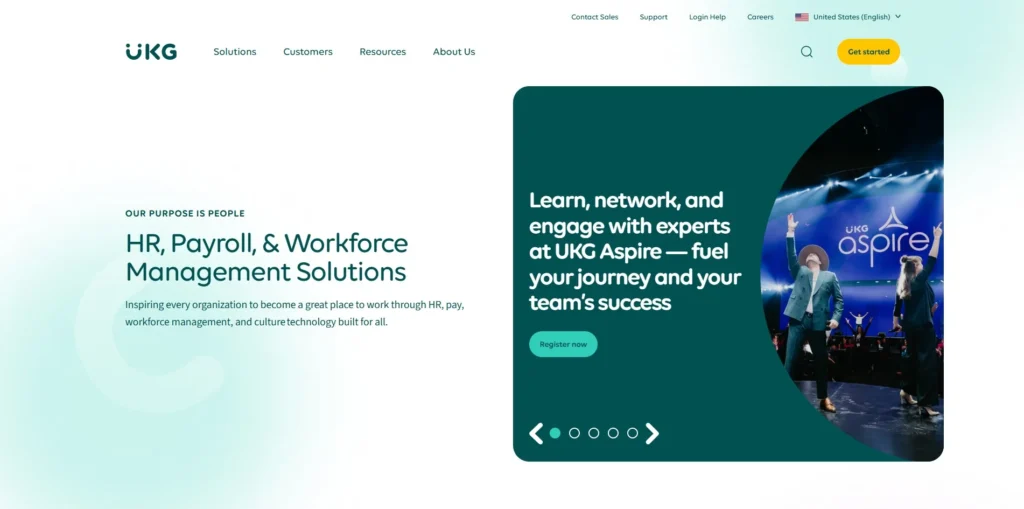
Website: https://www.ukg.com
UKG Pro is a global HCM solution that combines HR, payroll, talent, and benefits administration in one unified platform. With its benefits module, organizations can provide employees with diverse plan options while maintaining compliance with global and local regulations. UKG Pro continues to be a favorite among large enterprises thanks to its scalability and AI-driven insights.
The system supports complex enrollment workflows, automates benefits eligibility tracking, and integrates with payroll. Employees benefit from intuitive decision-support tools that help them choose the right plans, improving satisfaction and retention.
Key Features:
- Automated open enrollment and eligibility tracking.
- AI-powered decision support for employees.
- Global compliance coverage.
- Real-time integration with payroll and HR modules.
- Advanced analytics and reporting.
Pricing:
- Enhanced – $630/month
- Enhanced Plus – $775/month
- Elite – $1,050/month
- Platinum – $2,800/month
12. PlanSource
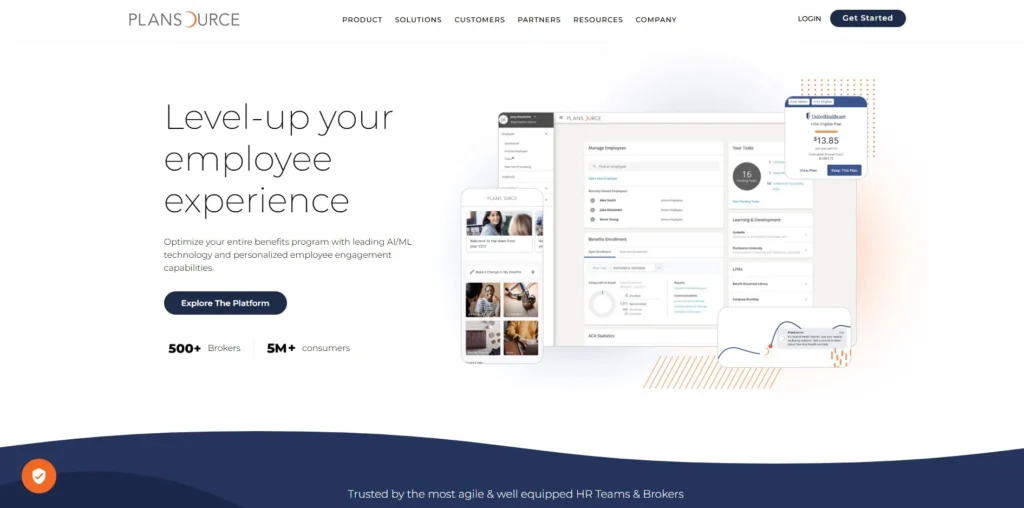
Website: https://www.plansource.com
PlanSource is a cloud-based benefits administration platform designed to simplify the entire benefits lifecycle for mid-sized and large organizations. It provides automated open enrollment workflows, life-event processing, and compliance support.
Employees get guided plan comparisons and mobile-first enrollment, while HR teams enjoy integrations with leading payroll providers and insurance carriers. PlanSource is also known for its strong broker partnerships, making it a preferred choice for businesses that want flexibility in benefits setup.
Key Features:
- Automated open enrollment and life-event management
- Mobile-first employee self-service experience
- ACA and COBRA compliance tracking
- Strong broker and carrier connectivity
- Reporting dashboards for cost and participation insights
Pricing:
- Custom pricing; quotes available upon request.
13. Employee Navigator
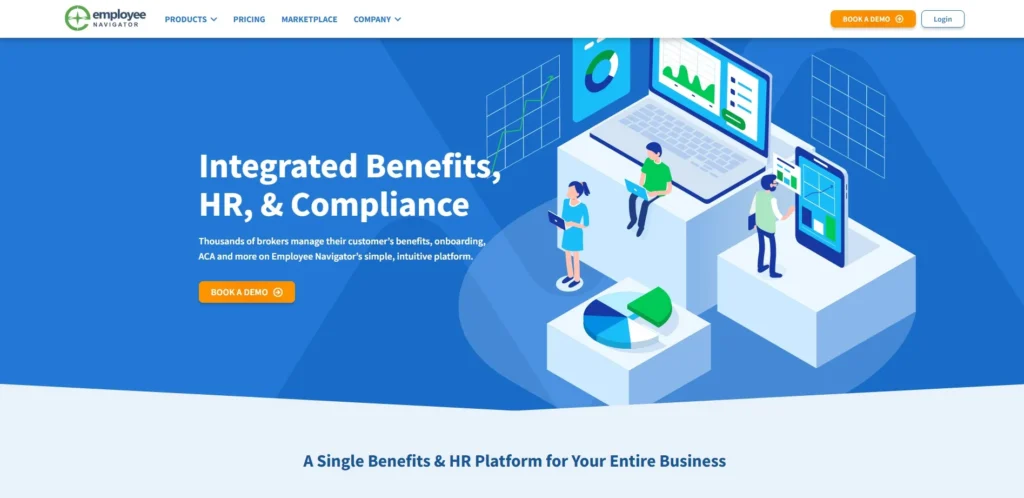
Website: https://www.employeenavigator.com
Employee Navigator is a benefits administration platform popular among brokers and small to mid-sized businesses. It enables companies to digitize benefits enrollment, track compliance, and integrate with insurance carriers. Employees can compare plan options, update dependents, and enroll via a clean, self-service interface.
HR leaders benefit from compliance reporting and streamlined workflows that reduce manual errors. Its affordability and broker partnerships make it especially attractive to SMBs.
Key Features:
- Digital enrollment for medical, dental, vision, and voluntary benefits
- ACA compliance tools with built-in reporting
- Integration with hundreds of insurance carriers
- Streamlined HR workflows for onboarding and life-event changes
- Mobile access for employees
Pricing:
- Enhanced – $630/month
- Enhanced Plus – $775/month
- Elite – $1,050/month
- Platinum – $2,800/month
14. Ease
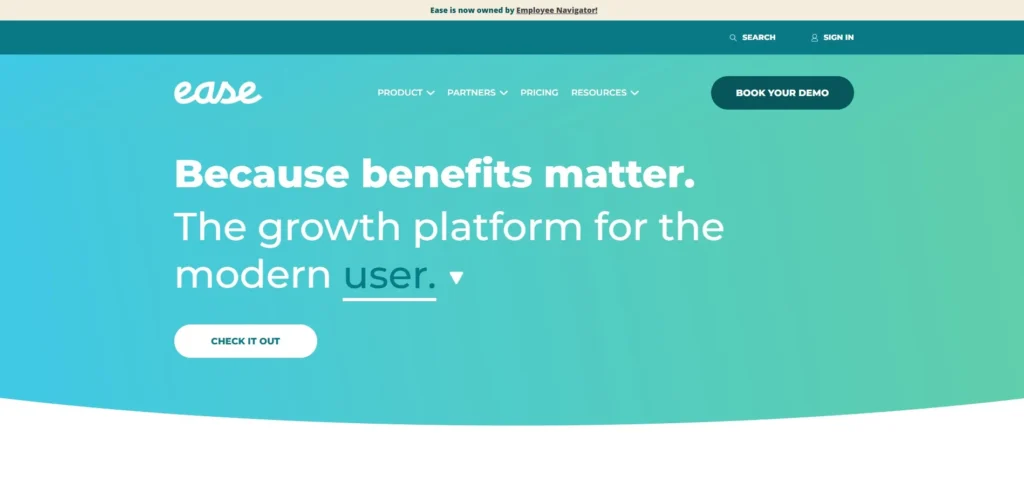
Website: https://www.ease.com
Ease is a benefits administration and HR platform designed primarily for small businesses working with insurance brokers. It simplifies digital enrollment, compliance management, and HR documentation. Employees benefit from an intuitive portal where they can compare plans, enroll online, and access benefits information anytime.
For brokers, Ease provides strong tools to manage client benefits, automate communications, and generate compliance reports. Its lightweight design makes it ideal for companies without large HR teams.
Key Features:
- Online enrollment with guided plan comparisons
- Broker-focused features for benefits setup and management
- Compliance documentation and ACA reporting
- Employee-friendly self-service portal
- Cloud-based and mobile-ready access
Pricing:
- Pro: $530 / mo*
- Agency:$840 / mo*
- enterprise: Custom
15. Justworks
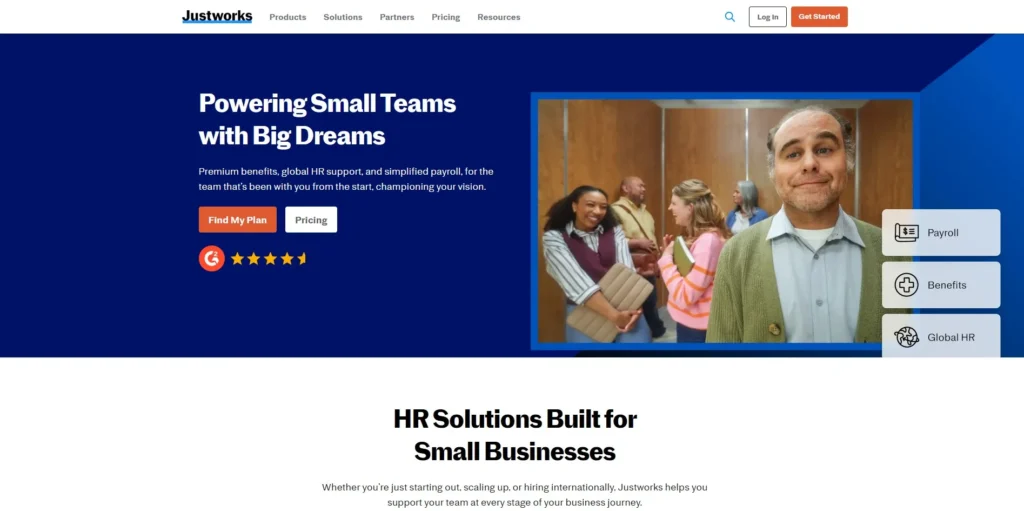
Website: https://www.justworks.com
Justworks is a modern PEO (Professional Employer Organization) and benefits administration platform designed for SMBs. It simplifies HR, payroll, compliance, and benefits by combining them into a single service. Justworks is particularly popular among startups and small businesses in the U.S. that want access to enterprise-level benefits without negotiating directly with carriers.
Employees get access to health, dental, vision, wellness programs, and retirement options, all managed digitally. Justworks also provides compliance assurance and dedicated customer support, making it one of the most user-friendly PEOs on the market.
Key Features:
- Access to Fortune-500-level benefits for small teams.
- Full-service HR, payroll, and compliance.
- Employee self-service benefits portal.
- Transparent pricing with no hidden fees.
- 24/7 customer support.
Pricing:
- Payroll – $8/month per employee + $50/month base fee
- PEO Basic – $79/month per employee
- PEO Plus – $109/month per employee
- EOR (Employer of Record) – $599/month per employee
Challenges & Limitations (and How to Mitigate)
- High Complexity for Large Orgs: Complex eligibility and multiple carriers can extend implementation. Mitigate with thorough data cleansing and phased rollout by division.
- Integration Hiccups: Mismatched fields or timing between HRIS, payroll, and carriers cause errors. Mitigate with a data dictionary, test files, and automated feed monitoring.
- Change Management: Employees may be confused during the first digital OE. Mitigate with pre-OE comms, explainer videos, virtual office hours, and targeted nudges.
- Cost Transparency: Per-employee-per-month (PEPM) pricing, implementation fees, or broker arrangements vary. Mitigate by asking for a line-item quote and SLAs tied to file accuracy and support response times.
- Data Privacy: PHI and PII require strict controls. Mitigate by requesting SOC 2/ISO reports, pen-test summaries, and role-based access reviews.
Conclusion
Benefits administration works best when accuracy and employee experience go hand in hand. Software platforms simplify enrollment, ensure compliance, and reduce manual effort for HR teams. The right choice depends on company size and needs, but focusing on integration, compliance support, and ease of use helps narrow the options. With the right system, businesses can manage benefits effectively while showing clear commitment to their employees.
FAQs
Q1. What is benefits administration software?
It’s a tool that helps HR manage employee benefits like health plans, retirement options, and compliance.
Q2. Why do companies use it?
To cut errors, automate compliance, and make enrollment simpler for employees.
Q3. Is it suitable for small businesses?
Yes, many providers offer plans designed for smaller teams.
Q4. How does it help employees?
Employees can compare and enroll in benefits through easy self-service portals.
Q5. What should businesses check before choosing?
Look for compliance support, HR/payroll integration, and ease of use.
 Get 50% off on Vault theme. Limited time offer!
Get 50% off on Vault theme. Limited time offer!